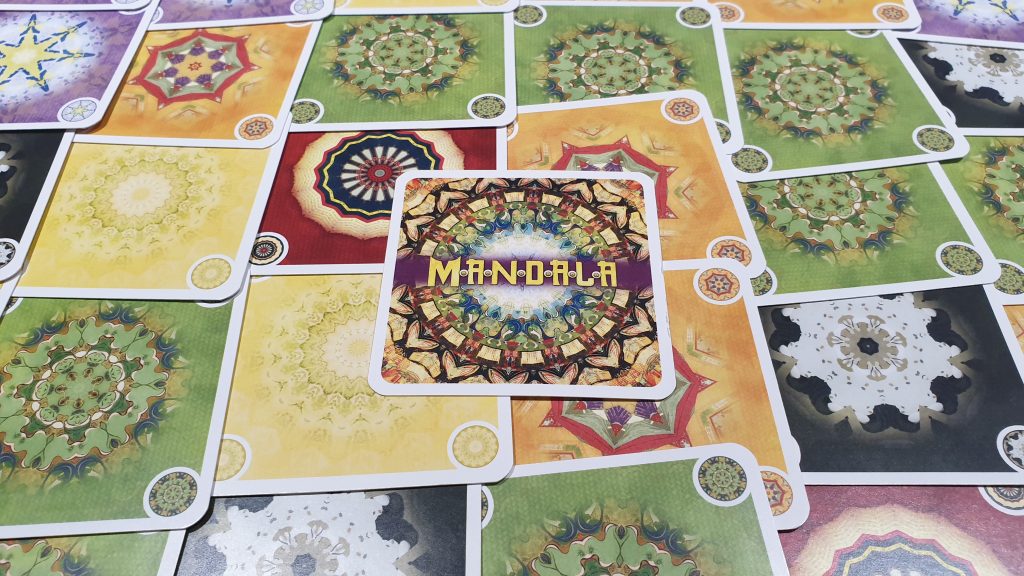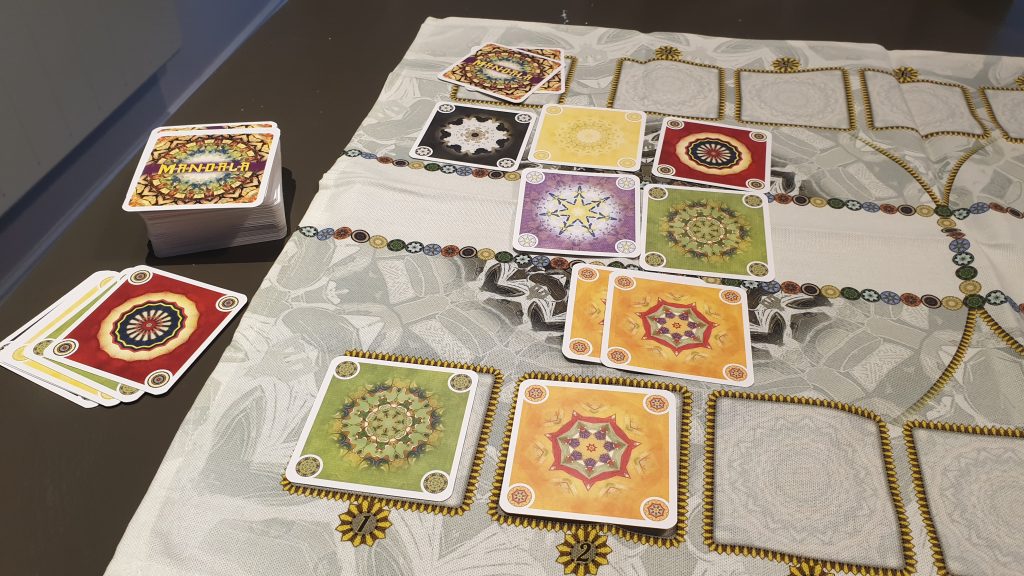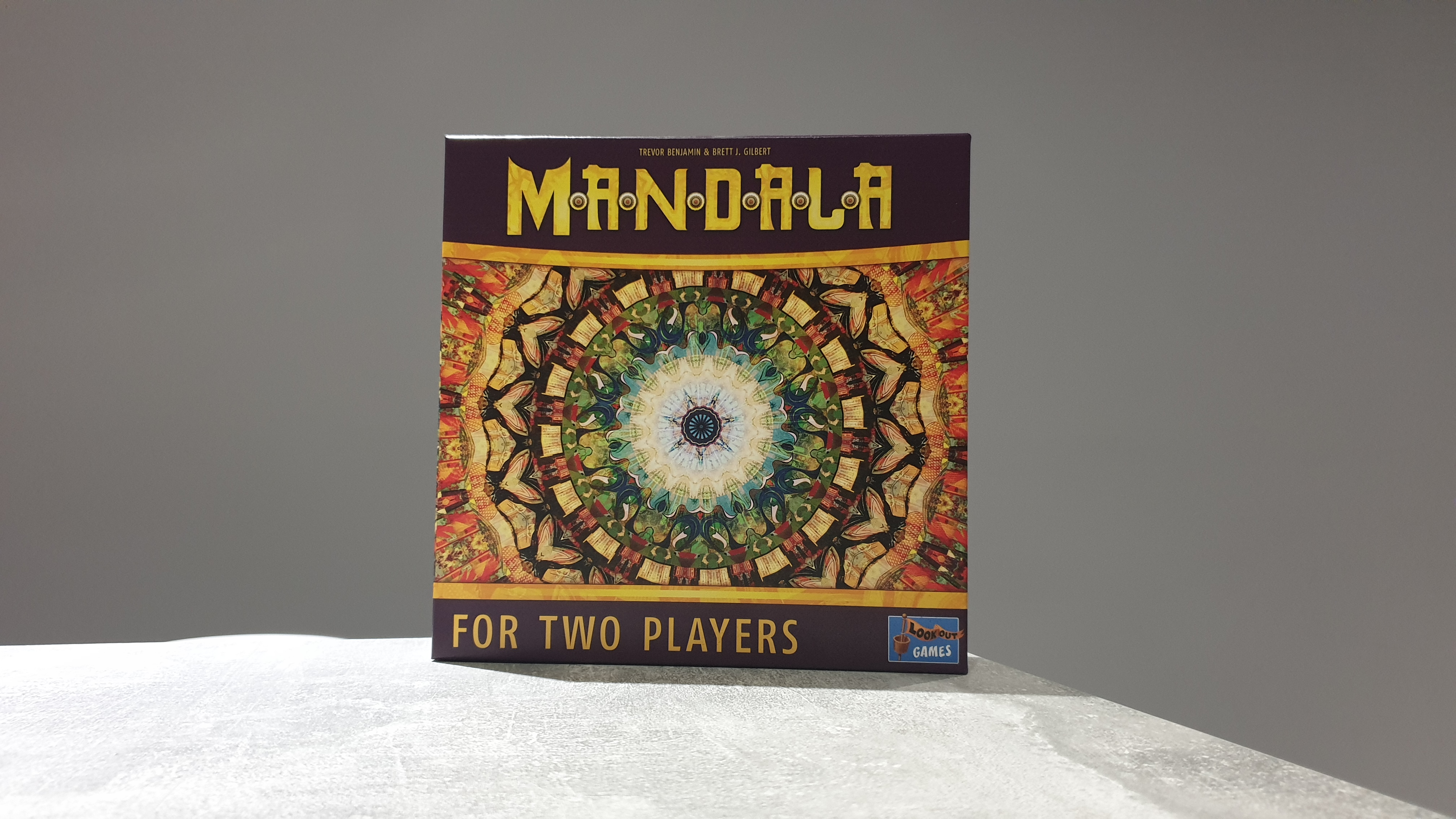Mandala is a brand new 2 player only abstract strategy board game from Lookout Games. Designed by Trevor Benjamin and Brett J. Gilbert, the game sees players aiming to collect colourful and hopefully valuable cards. Two central Mandalas will be built up and destroyed multiple times throughout the game, which lasts around 15 – 25 minutes. However, will the vibrancy of the colours extend to the gameplay? Let’s find out!
For the setup it is well worth properly shuffling the deck. Once this is done, it is time to throw down the linen game board and deal each player 6 cards. Each players’ cup, the pile of cards they score with, starts with two facedown cards and both mountains start with two face up cards. Then, the game is ready to go – with players able to peak at what starts in their cup as well as see what cards are in their hand.
To understand the game it is first best to understand the board and the rule of colour. The board is made up of multiple sections. Each player has on their side of the board a river with 6 slots – enough for one card of each colour in the game. In the middle are two Mandalas. These are made up of a central mountain and two fields – one being owned by each player. At any point in time each Mandala can only have each colour in one place. For example, regardless of the number of yellow cards in a Mandala they may only be in a single player’s field or the mountain.

On a turn players must perform one of three actions. At all times at least one action is available to players, though regularly there will be a choice present. A player may play a single card to a mountain, as long as it obeys the rule of colour, and if so draws up to 3 cards. There is a hard hand limit of 8, with player not able to draw past this number for any reason. At this point if all six colours featured in a Mandala it would be destroyed.
Instead, a player may choose to play a set of identical coloured cards to one of their fields, again obeying the rule of colour and potentially causing the destruction of the Mandala. An additional caveat is included that players cannot via the field action end their turn on zero cards. The final action available is to discard a set of coloured cards and redraw the number discarded.
Whenever a Mandala is destroyed it is an opportunity for players to gain cards, that may convert to points at the end of the game. Whomever has the most cards in their field connected to the destroyed Mandala takes all the cards of a single colour, followed by the other player if they had cards in their connected field. This goes back and forth until all colours have been taken, with cards in those fields discarded. One thing that is slightly different from normal is if a player finishes a Mandala but players draw on cards in their field it is the player that didn’t finish the Mandala that gets first pick.

When taking cards of a new colour the first is placed into your next empty river slot. The rest of that colour and other previously taken colours are added into the your cup. Two cards are then added to the now empty Mandala’s mountain. The game continues until either one player fills all 6 slots of their river or after a Mandala is destroyed once the deck has been fully depleted. Points are awards for cards in your cup. Each river slot is numbered 1 – 6 indicating the points earnt for cards of that colour in your cup. After calculating whomever has the most points wins!
The scoring system adds a layer of tactical decisions to the game. What you will score for different colours is on show for your opponent to see at all times, and vice versa. If a large number of a colour is available information on what your opponent will score for it is there to help you make the decision. This results in a meaningful decision that isn’t hard to calculate, therefore providing little opportunity for analysis paralysis. Being an uncomplicated way of scoring it also helps when a game ends, with the winner quickly determined.
On a turn players may only be presented with three possible actions but there is plenty to think about. Putting cards on a mountain may somewhat benefit both players unless timed correctly. Helping only yourself by adding to a field isn’t instantly better though. You’ll be stuck with less cards as a result, potentially opening up the opportunity for your opponent to maneuver things in their favour while you gather up cards. There is almost a tug of war between the two players of whom has the advantage as a result. So part of the game is all about not giving too much of said advantage away.

The production quality of Mandala is solid with a side of something special. The cards are decent, they shuffle well even though they are square. If placed on a board they wouldn’t seem out of place. However, there isn’t a standard board included in Mandala, instead there is an awesome linen playmat. It makes what could be a plain but pleasantly colourful game have a bit of impact when unboxed and each time it is setup. Rounding things off nicely are two reference cards that won’t be required after a game or two. These are ideal for remember the three actions during an initial game, making the play that bit smoother from the beginning.
The rules are for the most part extremely simple and easy to follow. The usefulness of the discard action is perhaps not explained fully, though it is also rarely used. Discarding avoids the infrequent issue of being unable to play any cards. It is also useful for cycling through the deck to either end the game faster or obtain that one colour you need. Potentially under used there have been many games where discarding didn’t even occur once. Often the ability to put one card on a mountain to draw three new cards is too enticing an offer.
Mandala is a small box game but it packs a fair punch of thinking in. The game revolves around timing getting cards into your hand, before both when and where to play them. The games are short enough and the game is engaging enough once finished you’ll want to shuffle and redeal for a rematch. It may not fill hours at a time but for a fast filler it is a tight two player experience. The production is almost surprisingly high, with the linen “board” giving Mandala the something special that it needs to stand out. As a two player only game it won’t be ideal for every gaming night yet Mandala is well worth a play!
[Editor’s Note: Mandala was provided to us by Asmodee for review purposes. As a standalone game it is currently available on 365 Games for £18.99. It is also available from local board game stores, find your local store here]

